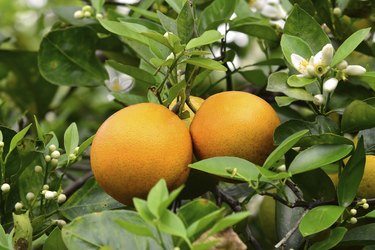
One of the four major citrus-growing areas of the United States, the mild-winter section of Arizona has the long, hot summers and mostly frost-free conditions necessary for growing orange trees (Citrus sinensis), which thrive in U.S. Department of Agriculture plant hardiness zones 9 through 11. Arizona's citrus-growing areas of USDA zones 9 through 10b extend from south-central areas to western boundaries of the state along the Colorado River. You may have to protect orange trees from occasional temperatures below freezing.
Watering Young Orange Trees
Video of the Day
In the low desert, the best time to add an orange tree to your garden is in spring, after all danger of frost has passed. University of Arizona Extension recommends March and April as the best planting time. For the first month after planting, water the tree every two to three days, going to every three to five days for the second and third months. Thereafter, decide when to water according to weather as well as tree age and size. During Arizona's hot, dry summers, trees up to two years old may need watering every two to five days. In winter's cooler, moister conditions, water these trees about every 14 days in December through February.
Video of the Day
Watering Older Trees
Trees older than three years old can go 10 to 14 days in summer between waterings. The larger the tree, the more gallons of water a day it needs. For instance, in July a 6-foot-wide tree uses 5.4 gallons a day, and a 14-foot-wide tree needs 29.5 gallons daily. You can basin-irrigate your tree or put it on drip irrigation, and the water should soak at least 2 feet into the soil at each watering. Avoid shallow, more frequent waterings.
Fertilizer Needs
Young trees don't need fertilizing until they've been in the ground for two years, according to University of Arizona Extension. After that, fertilize trees three times a year with equal amounts of a citrus fertilizer such as 6-4-6 plus minor elements. Apply 3 tablespoons per 9-square-foot area, scattering the granules under the branches out to the branch ends, keeping it away from the trunk. Immediately water it in. Months for fertilizer application are January or February, April or May and again in August or September.
Orange Tree Pests
Ordinarily, orange trees have few pests or disease. Make a habit of observing your tree every week or two, however, to monitor it for problems. Occasionally, sap-sucking insects such as aphids feed on new growth. Less than 1/8 inch long, aphids cause leaves to curl or become distorted, and often sticky honeydew is present. Hose aphids off with a strong spray of water as soon as you see them. A more conspicuous feeder, gray, tan and cream orange dog caterpillars may eat orange tree leaves. They turn into giant swallowtail butterflies. Hand-pick the caterpillars to remove them.
Orange Tree Diseases
A fungus naturally present in Arizona soils can cause phytophthora foot rot, invading orange tree tissues at or below the soil line. The bark cracks and exudes a gummy substance. Prevent its occurrence by using orange trees grafted onto fungus-resistant rootstock and by keeping the tree's grafting union well above ground. Another fungus called sooty canker affects injured bark but not healthy bark. It causes black growths under bark. Avoid injuring bark with weed whips or exposing trunk or branches to sunburn or to freeze damage.
Frost Protection
To protect orange trees from freezing weather, which can damage leaves, branches and even tree trunks, depending on the severity of the cold, cover the tree with blankets, sheets or frost blankets. Hold the fabric away from the plant with a framework of some sort so it doesn't touch the leaves. For young trees, also wrap the trunks with insulating material such as several layers of newspaper, fabric or cardboard.
Sunburn Protection
At the other extreme, hot summer sun can damage orange tree bark and branches, especially on young trees or in areas newly opened to the sun. Paint the trunk and branches with a white latex tree trunk paint before the sun hits them. You can also temporarily wrap branches loosely with paper or fabric.
- The Arizona Experience: Citrus
- Floridata: Citrus Sinensis
- U.S. Department of Agriculture: Plant Hardiness Zone Map
- University of Arizona Master Gardener Journal: Master Gardener Citrus Clinics: Citrus and Deciduous Fruit Special Supplement
- University of Arizona Cooperative Extension: Diagnosing Home Citrus Problems
- University of Arizona Cooperative Extension: Diseases of Citrus in Arizona
- University of Arizona Cooperative Extension: Irrigating Citrus Trees